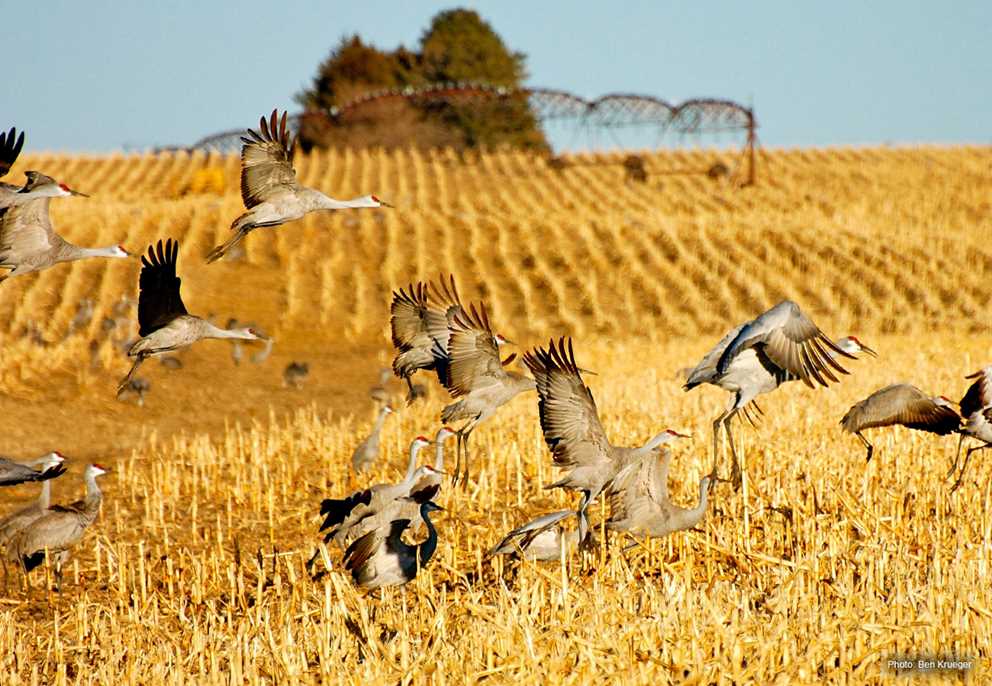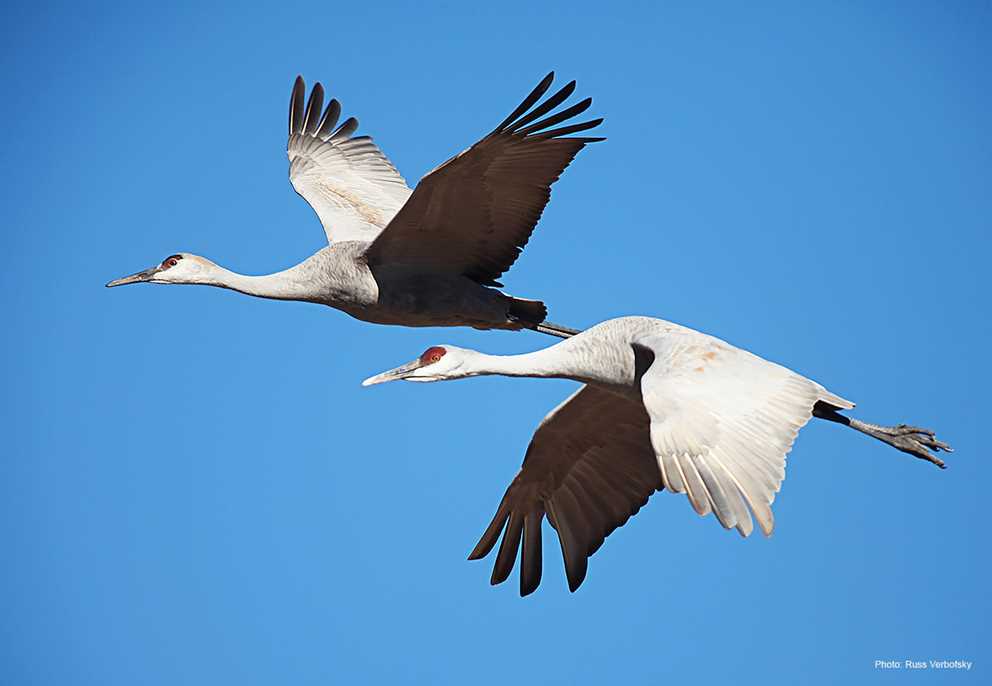Overview
The Sandhill Crane is a large wading bird endemic to North America. There are six subspecies (A. c. canadensis, A. c. nesiotes, A. c. pratensis, A. c. pulla, A. c. rowani, and A. c. tabida) organized in nine subpopulations. Six of the subpopulations are migratory (Eastern Flyway, Mid-Continent, Rocky Mountain, Lower Colorado River, Central Valley, and Pacific Flyway) and three are non-migratory (Cuba, Florida, and Mississippi). Their breeding range extends from Maine, New York, and Quebec west across the Great Lakes states, most of central Canada to Alaska. Isolated breeding populations occur in the Rocky Mountain, the Pacific North West (Washington, Oregon, Idaho and extreme northern California), southeastern Mississippi, southeastern Georgia and northeast Florida, and Cuba. Migratory populations of Sandhill Cranes winter in the California Central Valley, Lower Colorado River of California and Arizona, southern Arizona, Texas (High Plains to Gulf Coast and Rio Grande) and the northern Central Highlands and Gulf Coast of Mexico.
The plumage of Sandhill Cranes does not differ between the sexes. Sandhill Cranes are distinguished by long legs, necks and bills, and gray plumage with variable overtones of rust or brown (often more apparent in iron-stained plumage), and a bright red crown contrasting with white cheeks is present on all but young of year birds. Juvenile or first year birds are generally similar in appearance to adults but have more brown to rust coloration giving a mottled appearance to the body plumage. They are easily distinguished in flight by the outstretched neck and legs, and steady relatively slow wingbeats. In migration, they often soar on thermals, sometimes at altitudes where they can only be heard but not easily seen. The only similar species in North America is the Whooping Crane, which are white and longer than the Sandhill Cranes, and have notable entirely black primary feathers, whereas Sandhill Crane primary feathers are only tipped in black.
Description
Key Identification Features
- Sandhill Cranes are distinguished by long legs, necks and bills, and gray plumage with variable overtones of rust (often more apparent in iron-stained plumage) and a bright red crown contrasting with white cheeks is present on all but young of year birds. The legs and feet are black.
- Juvenile or first year birds are generally similar in appearance to adults but have more brown to rust coloration giving a mottled appearance to the body plumage. They lack the red skin and contrasting white cheeks on the head.
- They are easily distinguished in flight by the outstretched neck and legs, and steady relatively slow wingbeats. In migration, they often soar on thermals, sometimes at altitudes where they can only be heard but not easily seen. There is considerable variation in size among subspecies and populations of Sandhill Cranes from north to south.
Male/Female Average Length and Weight
- Mass: Males 8.0–11.7 lbs.; Females 7.1–11.1 lbs.
- Total Length: 42 in.
- Wingspan: 77 in.
- Culmen (Bill) Length: 3.4–5.4 in.
Male/Female Identification
- Basic Plumage: The sexes are similar. The plumage of Sandhill Cranes does not differ between the sexes. Sandhill Cranes are distinguished by long legs, necks and bills, and gray plumage with variable overtones of rust (often more apparent in iron stained plumage) and a bright red crown contrasting with white cheeks is present on all but young of year birds. The head of is mostly bare red skin from the base of the bill and above the eyes to the back of the head. They have stout pointed bills used to forage on a variety of plants, seeds, grains, small vertebrates, and invertebrates on or just below the soil surface. The legs and feet are black. Juvenile or first year birds are generally similar in appearance to adults but have more brown to rust coloration giving a mottled appearance to the body plumage, and they lack the red skin and contrasting white cheeks on the head.
Vocalizations
- Vocal. Often described as trumpeting, bugling, rattling, or croaking. Very loud and often heard at great distance, especially when migrating.
Similar Species
- Whooping Cranes: The only similar species in North America is the Whooping Crane, which are white and longer than Sandhill Cranes and have notable entirely black primary feathers, whereas Sandhill Crane primary feathers are only tipped in black.
Habitat Preferences
- Sandhill Cranes generally prefer freshwater marshes and emergent wetlands for nesting. They often forage in uplands, using grasslands, pastures, savannahs, and harvested crop fields to seek seeds and grains, and small vertebrates and invertebrates. They prefer to roost in shallow wetlands.
Foraging Habits and Diet
- Sandhill Cranes are opportunistic and consume seeds and grains, small vertebrates, and invertebrates. They have adapted to using harvested grain fields during migration and winter, where they seek grain, rodents, and insects. They will also consume plant material including tubers and vegetative parts of various aquatic plants.
Breeding Habits
- Monogamy: Sandhill Cranes are monogamous with long term pair bonds, and extended biparental care of offspring. Pair bonds may be broken after unsuccessful nest attempts. Pair formation is usually in spring on migration staging areas. Upon arrival in breeding areas, pairs maintain territories, and nests are initiated from April to late May, depending on population and latitude.
- Nest Location: Nests are usually in water on floating piles of vegetation.
- Clutch Size: 1 to 3 eggs. The eggs are pale brown to light olive, sub-elliptical to long-oval, and are 3.7 by 2.3 in. The incubation period is about 30 days. Renesting up to three times occurs when nests are lost during laying or early incubation.
- Sandhill Crane colts are nidifugous and leave the nest soon after hatching. The female often broods the young up to about 2–3 weeks of age. Both parents feed the young, especially during the first 10 days post-hatching. Parents stay within 200 m of the nest site for the first 2 weeks post-hatch, then gradually expand the foraging range as colts become larger and more mobile.
Migration & Distribution
- Birds in Cuba, Florida and Mississippi are nonmigratory. Otherwise, timing is somewhat variable among populations. The Eastern Population migrates from the Great Lakes breeding grounds to areas in Tennessee, Alabama, Georgia, and Florida, with fall migration starting in September to as late as December or January depending on winter weather condition. Spring migration is from February to April.
- Birds in the Mid-Continent Population depart breeding areas September and October, arrive in wintering areas in October to December. Spring migration is February through April, with arrival on breeding areas in April and May. Remaining populations have similar timing to the Mid-Continent Population.

Conservation Status
- IUCN Status: Least Concern
- Population Status: The USFWS annually estimates the population status of four subpopulations – the Mid-Continent, Rocky Mountain, Lower Colorado River Valley, and Eastern. In 2024, the Mid-Continent spring population three year average (2022–2024) was 819,494 birds. The Rocky Mountain subpopulation had a three-year average of 23,287 birds (2021–2023). The Lower Colorado River Population had a winter three year average of 4,554 (2022–2024). The Eastern Population had fall three-year average of 102,613 (2021–2023). The remaining populations include the Central Valley Population which had an estimated at 14,000 in the year 2000. The Pacific Flyway Population was estimated at 25,000, but this estimate is dated (1982), and the USFWS maintains a goal of 20,000–25,000. The population in Cuba is estimated at 500. The Florida Population is estimated to be 4,000–6,000 birds. Two Endangered subpopulations occur, and the Mississippi Population which is estimated to be 100–125 birds and the Cuban Population which is estimated at 500 birds. Summed, these estimates suggest that the continental population is very roughly 900,000–1,000,000 birds, but management at the subpopulation level is critical given the differing dynamics of each subpopulation.
- Conservation Concerns: Challenges differ by subpopulation, but overall primary threats include habitat loss in breeding areas, changes in agricultural practices across breeding, wintering, and migratory stopover sites, the spread of invasive plant species that degrade habitat quality, and collisions with power lines. Endangered populations in Cuba face habitat loss due to the expansion of sugarcane and rice agriculture, river damming, and grassland degradation caused by woody plant encroachment. The Mississippi Endangered population is primarily threatened by habitat loss as savannas degrade into forests.
- Conservation Focus: Maintenance of wetland habitats for non-migratory populations and staging and wintering areas for migratory populations are top priorities. Measures to mitigate power line collisions include managing habitats to minimize bird flights across power line corridors and enhancing power line visibility. The Mississippi Endangered population is supplemented with captive reared birds.
Harvest Information
- Hunting harvest of Sandhill Cranes occurs from the Mid-Continent Population, the Rocky Mountain Population, and the Eastern Population.
- Estimated harvest of Sandhill Cranes from the Mid-Continent Population in the 2023–2024 hunting season was 76,000 (~84,000 including crippling loss) in the US, and 13,500 in Canada (2022). Hunting harvest in the Rocky Mountain Population was estimated at 1,400. Harvest of Sandhill Cranes from the Eastern Population (hunted in Kentucky, Tennessee and Alabama) in the 2023 –2024 was 868 birds based on issuance of 5,741 permits.




